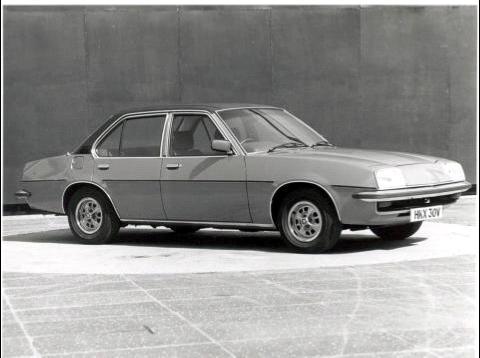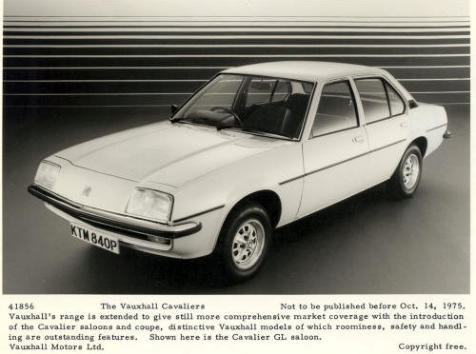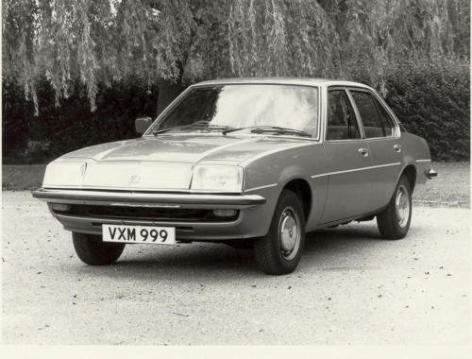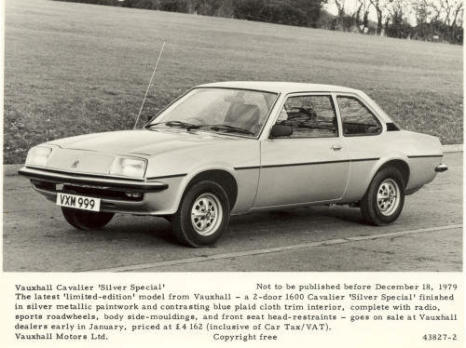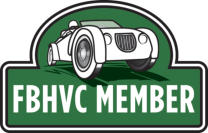Cavalier Mk1 Saloon
1975 to 1981


Welcome to the Cavalier and Chevette Club
Your friendly Vauxhall - Opel Club since 1994
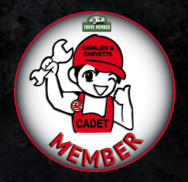

© Cavalier and Chevette Club 2023
We acknowledgement to Vauxhall Motors Ltd

Production Dates:
September 1975 to July 1981
Production Location:
Antwerp, Belgium 1st September 1975 onwards. Luton, UK 26th August 1977 onwards.
Program Code:
GM Europe U-Car.
Total Production:
238,980
Head of Production:
Ed Taylor/Wayne Cherry
Head of Engineering:
Doug Bull Chief Engineer Passenger Cars.
The U car programme was, at least on the surface, a second attempt by General Motors to produce a "world car" the first being the T car (Vauxhall Chevette / Opel Kadett C). However, it was originally intended as a European car for Opel as a replacement for their
Ascona and Manta A. It was a big success where it was sold in Europe and the UK, and to a lesser extent in South Africa, but wasn’t really sold anywhere else. Prototypes were evaluated by Holden in Australia but found the car to be unable to cope with conditions
down under without some serious chassis modifications and in any event they were already covering the U car’s sector of the market with their own design – the Holden Torana.
Vauxhall were not initially planned to be part of the U Car programme at all, work had already started on the Viva HC replacement, the HD/Cerian, in 1972 headed up by Vauxhall’s new Design Director Ed Taylor and Chief Engineer for passenger cars Doug Bull. The
plan was to move the car upmarket in size and price to compete in the mid-range head on with the Ford Cortina and increase Vauxhall’s share of the burgeoning company car market, the target launch date was late 1976 and a name change from Viva was also being
planned - to Cavalier. The move up in size would then leave room for the planned Chevette to slot in underneath in the range and which was due to begin production early in 1975, which it did. Several HD/Cerian mock ups were built, all featuring the yet to be familiar
droop snoot front end style, but the whole project was canned late in 1973 after the disastrous Canadian sales performance of the HC and mounting financial losses at Vauxhall which ended up forcing out Managing Director Alex Rhea. Rhea’s replacement was Bob
Price who was appointed Managing Director in January 1974. By this time sales were in freefall and a new mid-range model was still needed - and quick. Opel were already well advanced on their U car programme replacement for the Ascona and Manta. Price acted
quickly and by February 1974 Vauxhall's previous HD/Cerian model plans were merged into the U Car project, as Price would later state in an interview this saved 2 years of development and £50m. Luton’s Design Department set about adapting the Opel version of
the U Car to become recognisable as a Vauxhall and these could have been far more extensive than what ended up going into. There were a total of six different mock ups made for the saloon and one for the Coupe, all with different and extensive variations of front
and rear styling but in the end, because of cost and time constraints, a fairly simple and straightforward change at the rear and a "droop snoot nose" for the front differentiated them from the Opel Ascona, but the Manta adopted the Vauxhall front, albeit with air
slots added, and shared the same headlamps. One of the two names that had been pencilled in for the HD, Cavalier, was adopted for the U Car. The other factor that restricted changes was where it was going to be built, at least initially, in General Motors plant in
Antwerp Belgium alongside the Cavalier’s Opel cousins.
The car was first shown to dealers on the 29th September 1975 at the Elstree Film Studio’s in Studio 6. At that time Elstree Studio’s had fallen on hard times and would have welcomed Vauxhall’s money with open arms. The launch was in Studio 6 which was on the
part of the site that was sold to Tesco’s. Tesco’s now stands where Studio 6 was. The launch involved an ice Rink with 6 cars being pushed around the ice. The actor Patrick Macnee best known for his role as John Steed in The Avengers and The New Avengers was
involved in the launch, don’t forget that around this time he made two adverts for Vauxhall. Also at the launch was the full cast of Monty Python (Graham Chapman, John Cleese, Terry Gillham, Eric Idle, Terry Jones and Michael Pailn) they were promoting there film
Monty Python and the Holy Grail which had not long been out as well as joking about the common market and Eric Idle also performed a song. After the dealer launch the cars were put in the underground car park at Elstree Studio for a few days before the cars
were taken in secret to Earls Court. However the Vauxhall Cavalier Mk1 2-door 1600 GL was left in the underground car park due to a policy change by General Motor’s.
In fact it was not even certain if the car would be shown at all or even which models would be available, a 2 door GL Saloon was photographed hidden in the underground car park at Elstreet Studio’s but was never shown or sold in the UK. In the end the car was
launched at the last minute at the October 1975 Motor Show as planned - although Bob Price was on hand to answer the many awkward questions from journalists. The launch also forced Opel to reduce the price of the Ascona & Manta models they were selling in
the UK.The initial range available in the UK was made up of a 1600L 2 & 4 door Saloon, a 1600GL 4 door Saloon and a GL 1900 2 door Coupe which featured a deep front spoiler that was never used on the Opel Manta in the UK, it was in Europe on the Manta GT/E.
The 1900 engine was an option on the GL Saloon and not initially a model in it's own right. All were imported from Belgium, the Opel Ascona and Manta launched in August 1975 were made in Bocham Germany as well as Antwerp. One difference between the
Cavalier and Opels was the under-body protection which was far more comprehensive on Vauxhalls and was in line with the other models such as the Chevette and Viva.
In export markets the 1256cc engine was available in the Cavalier within months of launch, unlike in the UK, in both L and GL trim, Saloon and also the Coupe. Sweden was the only market where a 1900 GL 2 door Saloon was available. The car was an instant hit in
Britain with both private and company car users, the biggest problem was always supply which did not catch up with demand until the sales slump of 1980 when things were the reverse and Vauxhall had fields full of Cavaliers without buyers. The initial range
available in the UK was made up of a 1600L 2&4 door Saloon, a 1600 and 1900 GL 4 door Saloon and a GL 2 door Coupe which featured a deep front spoiler that was never used on the Opel Manta in the UK, it was in Europe on the Manta GT/E. All were imported
from Belgium, the Opel Ascona and Manta launched in August 1975 were made in Bocham Germany as well as Antwerp. One difference between the Cavalier and Opels was the under-body protection which was far more comprehensive on Vauxhalls and was in line
with the other models such as the Chevette and Viva. In export markets the 1256cc engine was available in the Cavalier within months of launch, unlike in the UK, in both L and GL trim, Saloon and also the Coupe. Sweden was the only market where a 1900 GL 2 door
Saloon was available. The car was an instant hit in Britain with both private and company car users.
The next major change was the launch of UK production of the Cavalier at Luton with the first car coming off the line on 26 August 1977 driven by Eric Fountain Vauxhall's Manufacturing Director. This also coincided with the British launch of the 1300 Cavalier using
the familiar Viva / Chevette 1256cc engine. As agreed with the unions, production of the Cavalier at Luton started with the 1300 but soon included the 1600 & 1900 versions, the only model not built in the UK was the Sportshatch which were all imported from
Antwerp. Once full production had been reached Luton began exporting cars to Europe.
Vauxhalls marketing division considered a basic model below the L specification Cavalier, as with the Chevette & Viva models. Called the Cavalier E it was shown to various fleet operators that Vauxhall already supplied for evaluation, the feedback was not very
positive and the idea was dropped. The E would have featured vinyl seats, no heated rear window, reversing lights and rubber floor covering. Another attempt was tried with carpets and called Cavalier Fleet was also rejected. In July 1976 the Engineering Department
at Luton fitted two Cavalier Coupe models with the 2.3litre slant four engine, one was a twin carburettor the other was a fuel injection version which was being developed for the VX4-90 but unlike the Silver Bullet it used a Lucas not Bosch injection system. The project
was fully evaluated but never progressed any further. The other project that didn’t even get beyond the studio mock up stage was the Estate, in both three and five door versions. Although Vauxhall were keen to plug an obvious gap in the Cavalier range Opel saw no
need to for the car as they felt the market was adequately covered by the Kadett / Chevette Estate and the larger Rekord / Carlton Estate so it would have meant Vauxhall going it alone and on that basis the investment could not be recouped within the lifespan of the
car, ironically the Mk2 Cavalier Estate which Vauxhall built in collaboration with Holden was far from successful. A diesel saloon version using the Bedford CF 2.1litre engine was also evaluated, it was already fitted to the Ascona in Europe, but the market in Britain was
deemed too small.
A limited edition model called the Silver Special based on the 2 door L model with many GL spec extras fitted was announced in December 1979. There were a host of improvements for the 1980 models which included a new 2000 GLS Saloon which included all the
extras including the sports instruments and steering wheel from the GLS Sportshatch. Soon after another trim level was available in the UK aimed at fleet buyers – the LS. This was available with 1600 and 2000 engines and a trim level closer to the GL but priced
nearer to the L. There were some minor trim variations for the 1981 model year until production finished in July 1981 at all plants ready for the replacement front wheel drive J Car Cavalier which was launched in September. The new Vauxhall Insignia’s roots come
from this car. With thanks to David at www.vauxpedia.net and James and Graham Turner.
Trim levels:
L
LS
GL
GLS


The first Cavalier built at Luton is driven off the line, the car was
a 1300 which was launched in the UK at the same time.
These two cars are the mock ups for the HD Viva/Cerian replacement and are a size up from the HC which would have taken them
into the mid-range company car market. Note the strange, for Vauxhall, door handle arrangement also the HC indicators at the
front and the family resemblance to the FE with the side window design - if it had reached production the rear window would not
have wound down fully. The car was not going to use the Viva name and even though these are only mock ups they are both
badged as Cavalier, the other name being considered was Chevelle.


The Cavalier Mk1 at Elstree Stuido's
The 2-door 1600 GL that was left at Elstree and not taken to Earls Court.
Two views of the U-Dash board mock ups.

Cavalier Mk1 in production at Luton.

A U Car mock up on the viewing terrace at the Design Department featuring a "Ferrari" style front
end design, both Ed Taylor Wayne Cherry, owned a Ferrari.
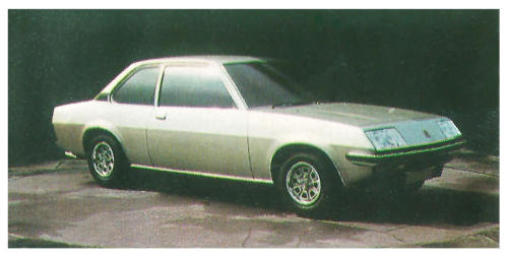
Another mock up on the viewing terrace this time getting closer to the final production appearance
apart from the flush headlights.


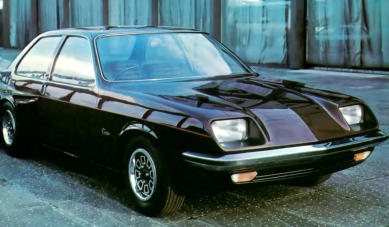
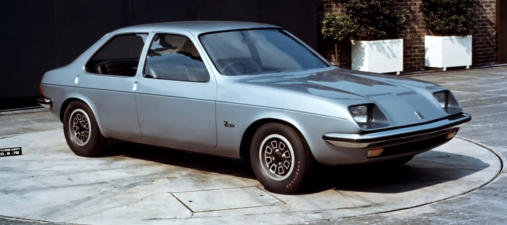
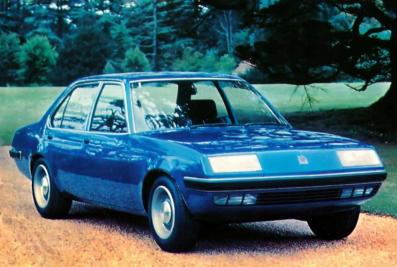


Possibly the best looking study of all with a very neat front end and bumper / lighting arrangement
again with Ferrari GT400 overtones.
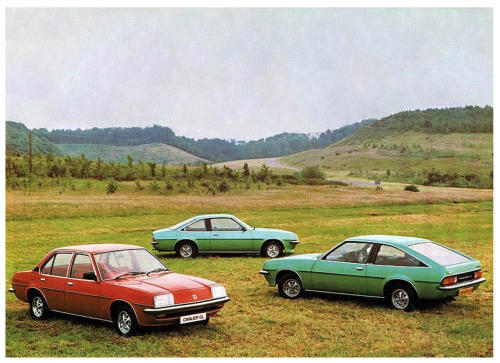
The range of Cavalier Mk1 body styles - Saloon, Coupe and Sportshatch.



